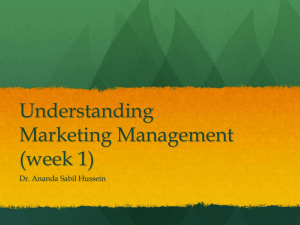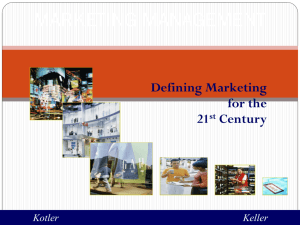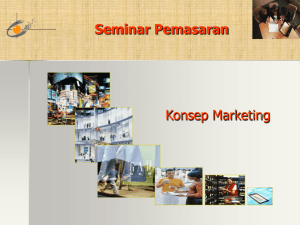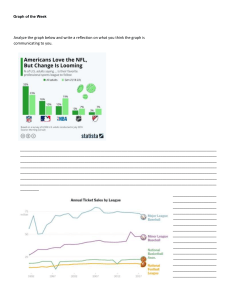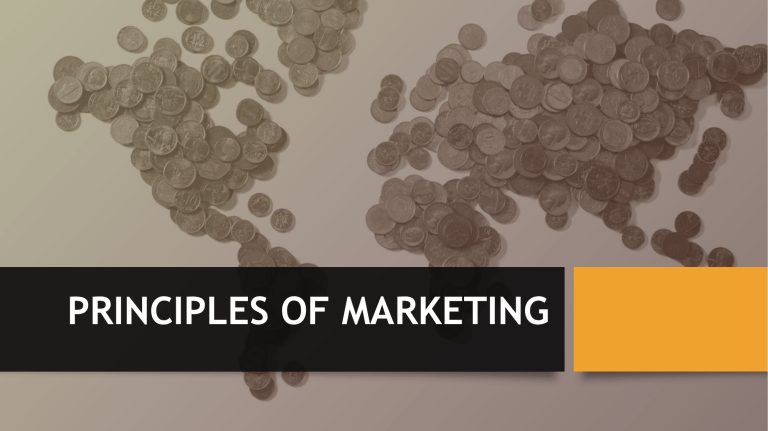
PRINCIPLES OF MARKETING OBJECTIVES • Define and understand Marketing and its goals • Identify the Elements of the Marketing Mix What is Marketing? • Name a famous tagline, phrase, or quotation that is identified with a company or product. Explain how and why this particular marketing schemes influences you. • While watching your favorite TV show, you see the newly launched commercial of a fast-food company-a family joyful eating fried chicken amidst a hearty conversation, then finishing off the meal with a satisfying “Hmmmmm!” After watching the commercial, do you feel that you want to grab the same meal at the exact moment to satisfy your hunger? Does the brand stick in your mind that you cannot wait to grab same meal on your next visit to the mall? That is marketing working on you. Companies use different means and channels to promote their brand so that consumers will remember it and choose to buy it the next time they get the chance. Marketing • According to the American Marketing Association (AMA), “Marketing is the activity, set of institutions, and processes for creating, communicating, delivering, and exchanging offerings that have value for customers, clients, partners, and society at large.” FUNCTIONS OF MARKETING In summary, MARKETING is… 1.Creation 2.Communication 3.Delivery of Value to Customers • Traditionally, MARKETING is all about ANSWERING THE NEEDS AND WANTS OF CONSUMERS. However, marketing in contemporary times does not just focus on having a one-time transaction with consumers. • While it is still true that companies design products based on the needs and wants of consumers, MARKETING NOW INCLUDES ACTIVITIES THAT FOCUS ON ESTABLISHING AND DEVELOPING CUSTOMER RELATIONSHIPS. It centers on providing benefits that consumers will enjoy to the extent that they make considerable repeat transactions, eventually leading to customer loyalty. Having loyal customers is important for businesses. • Marketing is a combination of different activities that communicate the benefits of a company’s product to its consumers. • Companies offer value (benefits from products) to consumers and, consequently, companies get value (profits) from consumers. “Products or services that serve no purpose or contribute nothing to individual and societal well-being should not be marketed.” GOALS OF MARKETING 1. Understand the market and its consumers and satisfy their changing needs and wants. 2. Introduce and innovate products and services that improve the human condition and the quality of life. 3. Design and implement effective customer-driven marketing strategies. 4. Develop marketing programs that deliver superior value to consumers.(Customer Loyalty Program-Rewards Card, Suki Card, SM Advantage) 5. Build and maintain mutually beneficial and profitable customer relationships. 6. Capture customer value to create profits. 7. Promote value transactions with full regard to society’s well-being.(Straw less Day) As a student, how do you experience MARKETING on a daily basis? YOUR EVERYDAY DECISIONS ARE INFLUENCED BY THE MARKETING MIX The Marketing Mix Marketing Mix The Marketing Mix •The marketing mix refers to the tactics (or marketing activities) that we have to satisfy customer needs and position our offering clearly in the mind of the customer. • The Marketing Mix is composed of the four elements also known as Four Ps: PRODUCT Creating Value PRICE Capturing Value PLACE Delivering Value PROMOTION Communicating Value Each element is vital to the concept of marketing, and they all interact with each other in order to deliver superior value both to the company and consumers. Without one component, the marketing mix will be incomplete. PRODUCT: Creating Value (Creating offerings) • PRODUCTS are goods or services that are offered to the market. • GOODS are items that you can touch physically; hence they are called TANGIBLE PRODUCTS. • SERVICES are INTANGIBLE BENEFITS a customer enjoys that are performed by people or machines. Name and address of the manufacturer, packer, or distributor; Product description, including contents, materials, and the amount of the product included. You may also include a serial number or a batch number for tracking purposes; Compliance marks for specific regulatory standards. PRICE: Capturing Value The monetary amount charged for the product (exchanging) • Captures the value of a product. • Normally, the price of a product equates to the benefits the product offers to consumers. In exchange for the product, a company captures value or profit from the payment made by a consumer. But price does not always equate to a monetary component-it may also refer to the time and energy that consumers give up in exchange for the product. • For example, when you go to school, you are not only spending money on tuition, but you are also spending time and effort to pass your subjects so you can graduate. The value that you get from going to school is also dependent on how much effort you put in to learn, pass school requirement, and get good grades. • This is the only revenue-generating element of the mix – all other marketing activities represent a cost. It is important to get the price right to not only cover costs but generate profit! • As far as the consumer is concerned, price is not everything. Quality, for example, and after-sales service also matter. However, price is an important consideration. • Your product’s price must be competitive. If there are rivals in the marketplace, you need to know as much as you can about their pricing strategies. PLACE: Delivering Value Getting those offerings to the consumer in a way that optimizes value • This is the ‘place’ where customers make a purchase. This might be in a physical store, through an app or via a website. Some organizations have the physical space, or online presence to take their product/service straight to the customer, whereas others have to work with intermediaries or ‘middlemen’ with the locations, storage and/or sales expertise to help with this distribution. PROMOTION: Communicating Value • PROMOTION is the component that informs, persuades, and reminds potential buyers of value they can get from a product. A powerful message can influence consumers to buy, and buy some more. • No matter how good a product is, if its benefits are not properly communicated, it will go unsold. • Choose the right tools and media that fit with what you are trying to achieve. Promotion is a very important component of marketing as it can boost brand recognition and sales. SELL YOUR MONEY! • Rubric TIME 5 POINTS STRATEGY 10 POINTS EFFECTIVITY 10 POINTS TOTAL 25 POINTS The Extended Marketing Mix People • A company’s people are at the forefront when interacting with customers, taking and processing their inquiries, orders and complaints in person, through online chat, on social media, or via the call center. They interact with customers throughout their journey and become the ‘face’ of the organization for the customer. Their knowledge of the company’s products and services and how to use them, their ability to access relevant information and their everyday approach and attitude needs to be optimized. • People can be inconsistent but with the right training, empowerment and motivation by a company, they can also represent an opportunity to differentiate an offering in a crowded market and to build valuable relationships with customers. Process • Process refers to how the service is delivered to the consumers. It includes the activities and procedures by which service is executed. Companies with well established processes are able to provide the same level of service delivery to every customer at any given time. Physical Evidence • Physical evidence provides tangible cues of the quality of experience that a company is offering. The presence of physical evidence creates a better customer experience. • For a restaurant, physical evidence could be in the form of the surroundings, staff uniform, menus and online reviews to indicate the experience that could be expected. For an agency, the website itself holds valuable physical evidence • The marketing mix or 7Ps helps us to stand out against competitors with an offering that satisfies customer needs, which is what MARKETING is all about. Marketing is communicating, delivering, and creating value for customer. ACTIVITY 1 Think of at least three products or services for which you felt you did not get the best value for your money. Elaborate on this experience and explain how this product or service could have been better. THANK YOU!
